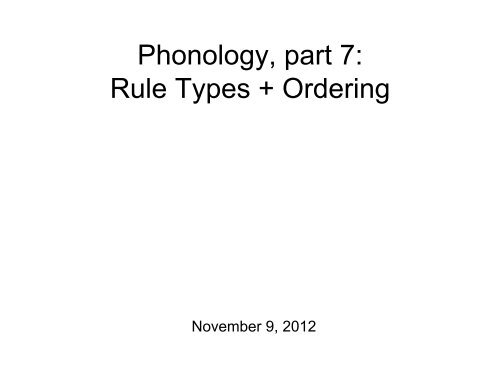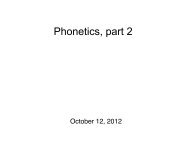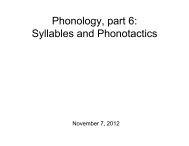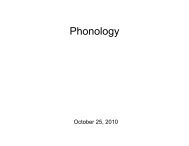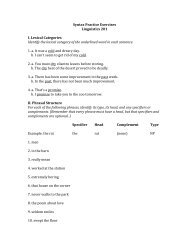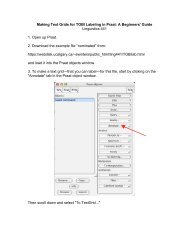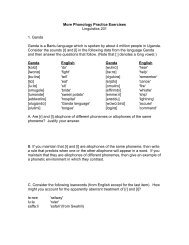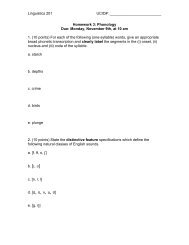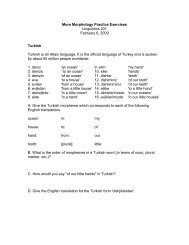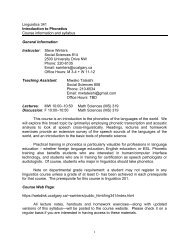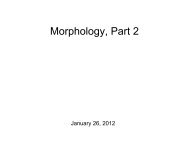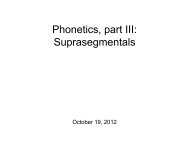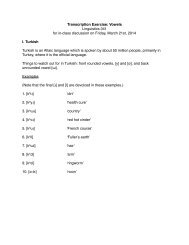Phonology, part 7: Rule Types + Ordering - Basesproduced.com
Phonology, part 7: Rule Types + Ordering - Basesproduced.com
Phonology, part 7: Rule Types + Ordering - Basesproduced.com
You also want an ePaper? Increase the reach of your titles
YUMPU automatically turns print PDFs into web optimized ePapers that Google loves.
<strong>Phonology</strong>, <strong>part</strong> 7:<strong>Rule</strong> <strong>Types</strong> + <strong>Ordering</strong>November 9, 2012
What’s the World Got in Store• Today:• Some <strong>com</strong>mon phonological rules• <strong>Rule</strong> ordering• And also: some more phonology practice exercises• Wednesday after the long weekend: <strong>Phonology</strong>Homework will be due at the beginning of class.• Homework has been posted to the course web page.• Starting next week: Syntax (grammar of sentences)
Them’s the rules!• One <strong>com</strong>mon phonological process we’ve seen so far isassimilation.• = one sound be<strong>com</strong>ing like another in its environment• One distinction: total vs. <strong>part</strong>ial assimilation• Partial assimilation: only <strong>part</strong> (e.g., one feature) of thetarget sound changes.• English: /in-/ + /probable/ = improbable• Total assimilation: the entire target sound changes tomatch another sound in its environment.• Arabic: /ʔal/ + /da:r/ = [ʔad da:r] “the house”
The Usual Suspects• Assimilation processes can also affect sounds indifferent directions.• Regressive assimilation: features spread backward intime.• Place assimilation in English: improbable• Progressive assimilation: features spread forward intime.• Ex: voicing assimilation for English plural marker.• [kæts] “cats” [dagz] “dogs”
Insertion• The phonetic shape of the plural marker in Englishalso depends on another phonological rule…• The following English plurals:matches judgeshosespasses• …and others like them exhibit an insertion rule.• Insertion: nothing → something / in someenvironment• Specifically: [I] insertion.• ∅ → [I] / [+strident] ___ [+strident]• A fancy (shmancy) name for insertion is epenthesis.
Deletion• Deletion: something → nothing / in some environment• English example (casual speech):‘fifth’ →• English example (casual speech):‘probably’ → [prabli]‘suppose’ → [spowz]• This also applies to /r/-dropping dialects…• and the deletion of final consonants in Hawaiian Creole.• “paint” → [pen]• “old” → [ol]
Dissimilation• Dissimilation: a change is made to a sound that makes itless similar to a sound in its environment.• Example (from Greek):/epta/ → [efta] ‘seven’<strong>Rule</strong>: [-continuant] → [+continuant] / ____ [-continuant]• Example (from English, casual speech):‘sixth’ →<strong>Rule</strong>: [+continuant] → [-continuant] / [+continuant] ____• These <strong>part</strong>icular rules exhibit manner dissimilation.• Dissimilation is relatively rare in the world’s languages.
Reduction• Reduction: phonemic contrasts can be lost in <strong>part</strong>icularphonetic environments.• Ex: English vowel reduction.• vowels →/ unstressed syllables• ~• ~• <strong>Rule</strong> of thumb:• phonemic representations should include all of theunpredictable information about the sounds in a wordform.• Phonological rules account for the predictable phoneticinformation.
Terminology• Since phonemic forms can sometimes not be seendirectly, they are often referred to as underlyingrepresentations.• In contrast, the phonetic forms are referred to assurface representations.• (we can see them directly)• The process by which phonological rules convertphonemic forms to phonetic forms is called a derivation.• The application of the rules can often take place inordered steps.• (although sometimes the order doesn’t matter…)
Deep Thoughts• Let’s say that the basic allophone for the plural markeris /z/.• it’s voiceless after [-voice] segments• an [I] is inserted after [+strident] segments• it’s voiced [z] everywhere else• Two rules have to apply to account for this pattern:• voicing assimilation• [I] insertion• The order of these rules matters. Which should go first?
The Wrong Way• Here’s what can happen if we apply the voicing assimilationrule first, in forming the plural for ‘pass’.phonemic form: /pæs + z/voicing assimilation:[I] insertion:p h æssp h æsIsphonetic form: *[p h æsIs]• This is wrong, because the phonemic /z/ has been devoicedin [Is].
The Right Way• Here’s what happens if we apply the schwa insertionrule first, in forming the plural for ‘pass’.phonemic form: /pæs + z /[I] insertion:voicing assimilation:p h æsIzphonetic form: [p h æsIz]p h æsIz (no change)• When the rules apply in this order, we get theappropriate phonetic form.• Moral: when more than one phonological rule can apply,you must make sure they apply in the correct order.
Today’s Mysterious Quick Write• We also know that phonology is going on underneath thesurface because...• Sometimes, we see the results of rules even after theconditions for applying them have disappeared• /t/ flapping in (North American) English“batter”“petal”“atom”• <strong>Rule</strong>: /t/ be<strong>com</strong>es a voiced flap at the start of anunstressed syllable
More Evidence• Flapping happens to /d/ in English, too.• /d/ flapping in (North American) English“madder”“medal”“ridden”• /d/ be<strong>com</strong>es a (voiced) flap at the beginning of anunstressed syllable• Sometimes, /t/ and /d/ can be<strong>com</strong>e indistinguishable:• “madder”• “matter”
Another <strong>Rule</strong>• Remember Canadian Raising? It only occurs in certainenvironments:• “house” “loud”• “write” “ride”• “pipe” “bribe”• “like”• [aj] and [aw] “raise” whenever they appear before avoiceless consonant.
True Patriot Sounds• Canadian English is unique in that it has the following<strong>com</strong>bination of phonological rules:• Flapping• alveolar stops be<strong>com</strong>es voiced flaps at the beginningof unstressed syllables• Raising• /aj/ →• /aw/ →/ ___ [-voice]/ ___ [-voice]• It turns out there are cases where both rules might apply--• Ex: the word “writer”• In these cases, which one should apply first?
The Hidden Order
The Right Way(s)• “write” + “-er” = “writer” (one who writes)phonemic form: /rajt/ + /r/raising:flapping:phonetic form:• “ride” + “-er” = “rider” (one who rides)phonemic form: /rajd/ + /r/raising: (does not apply)flapping:phonetic form:
The Wrong Way• “write” + “-er” = “writer” (one who writes)phonemic level: /rajt/ + /r/flappingraising: (does not apply)phonetic level: *• The diphthong in “writer” isfollowed by a voiced sound, even though it is• ⇒ Raising had to apply before flapping• Raising applied to units which don’t appear in thephonetic form!
By the way...• The technical term for this phenomenon is opacity.• You can’t see the environment for a phonological rule• You can only see its results• This is another example of structure in language that isnot apparent on the surface…• remember “unlockable”?• = morphological ambiguity• (Note: we’ll see it again)


